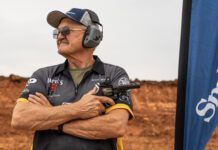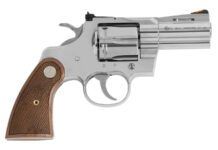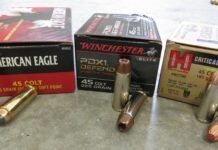The U.S. Ordnance Board has always invited side-arm manufactures to pit their designs against the competition to determine which firearms are best suited for combat. The Colt Single Action Army (SAA) seemed like a shoe-in after the Civil War because the Army liked the Colt Model 1860 percussion revolver. The Remington 1858 cap-and-ball revolver was also popular with the Army, but the days of loose powder and ball were ending. By 1870, technology had evolved, and Smith & Wesson had an edge, and Government orders. S&W sold the Army on the Model 3 revolver in 1870, which was the first self-contained metallic-cartridge-firing sidearm in U.S. service. Cartridges today are taken for granted, yet back then, cartridges were cutting-edge weaponry. The Army tweaked the Model 3 design and landed on a variant of the Model 3 called the Schofield revolver chambered in 45 S&W, also called 45 Schofield.
We decided to take a look at four modern replicas of single-action revolvers that were introduced between 1870 and 1875 and do our own abbreviated version of sidearm trials circa 1873. We looked for accuracy, point of aim, trigger weight, ease of use, and smooth actions.
Our entrants included a third-generation Colt SAA, which is descended from the original Colt SAAs used by the Army; an Uberti Outlaw Army, which is a replica of the Remington Model 1875; an Uberti 1873 No. 3 Top Break Model, which is a near clone of a Smith & Wesson No. 3 Schofield revolver and another revolver adopted by the Army; and finally a 21st-century newcomer from Taylor’s & Co. called the Drifter, which is similar to a traditional SAA revolver but with upgrades.
All of these revolvers are full size with either a 7- or 7.5-inch barrel. They all are chambered for 45 Colt, have fixed sights, six-round capacity, and are single action only. You need to cock the hammer then squeeze the trigger to make these old-timers go bang. The firing pin is built into the hammer, so the safest way to carry these revolvers is with the hammer resting on an empty chamber. The Schofield and Outlaw have a hammer-safety block that is activated when you cock the hammer back until you hear the first click. The Taylor’s uses Uberti’s retractable firing-pin safety system used in Uberti’s 1873 Cattleman II revolvers. The Colt uses late 19th-century technology that relies on the user’s common sense rather than a manual or built-in safety.
The Taylor’s, Colt, and Uberti Outlaw are similar in that they employ a right-side loading gate and ejector rod to load and unload the revolver one chamber at a time. The Uberti 1873 No. 3 is a top-break design that allows the user to flip a latch and rotate the barrel and cylinder away from the frame to eject all the empty shells at the same time. You can see right away that the Uberti/S&W Schofield has an edge with the ability to load and unload more rapidly than the other revolvers. With the other revolvers, the shooter loads and unloads one chamber at a time. Tedious at best, and we imagine nerve-racking when in a gunfight. While the Schofield has the advantage in loading and unloading, the original Schofield fired the 45 Schofield/45 S&W cartridge, which is shorter than the 45 Colt. The cartridge used a similar bullet weight as the 45 Colt, and on average, the velocity was 100 fps less. The 45 Schofield is also compatible with 45 Colt guns, so back in the day, the Army used the 45 Schofield cartridge in Colt SAA revolvers. Unfortunately, the 45 Colt could not be used in guns chambered for 45 Schofield. This was the downfall for the S&W Schofield revolver’s wider acceptance. The Army preferred the power of the 45 Colt cartridge, and the Army had plenty of 45 Colt ammo on hand, so the Schofield was dropped from the ranks. Luckily, Uberti’s modern take on the Schofield revolver chambers it in 45 Colt, so the Uberti is not an exact replica, but it is close enough for Government work.
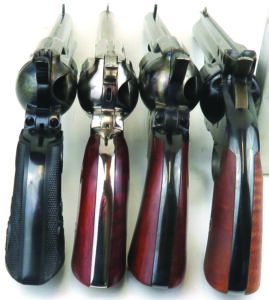
We decided to test both 45 Colt and 45 Schofield ammunition. For the 45 Schofield round, we used Choice Ammunition 200-grain RNFP (Round Nose Flat Point) lead Black Hi-Tek. The non-toxic Black Hi-Tek coating encapsulates the lead bullet, replacing standard dry lubricant. Hi-Tek coating has been used for years in other countries and shoots cleaner than bare lead. We can attest that the Choice Ammunition loads do shoot cleanly. This ammo is made in Montana. For 45 Colt rounds, we used a 250-grain RNFP Lead Hi-Tek Black from Choice Ammunition, a 255-grain RNFP from Hornady’s Cowboy line, and 250-grain LFN loads from Sellier & Bellot. Those cartridges rounded out the low-velocity cowboy-action-shooting-style loads. The modern 45 Colt load was a SIG V-Crown cartridge loaded with a 230-grain JHP bullet.
For accuracy testing we used our range bag as a rest and thumbed away at targets set at 15 yards. Our first impression was that some of the front-sight blades were thin and hard to see. We understand the adage “aim small, miss small,” but we needed to concentrate to be surgical with Outlaw and Schofield. All revolvers shot to point of aim, which can be a hurdle for some fixed-sight revolvers.
The triggers were the next characteristic that left an impression. The Colt had the worst trigger of the bunch, yet was the most expensive. The Taylor’s trigger and action were silky, and the Outlaw and Schofield started to smooth out after repeated firing.
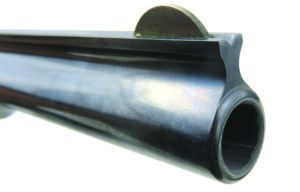
The third thing were the grips. The Colt and Taylor’s were typical SAAs with flat sides that flared out toward the bottom of the grip. We thought the Colt grips were toothy enough so the gun didn’t slip in our hand during recoil. The Taylor’s grip was smooth. The Outlaw had a fatter and rounded grip that filled our hands without it feeling too chunky. The Schofield grip was small, like a grip on a compact revolver.
For fast shooting, we used a Thompson Targets B27STOP Upper Torso Life Size Silhouette target ($7/5; ThompsonTarget.com), which features a T-shaped head and chest zone highlighted in bright red. We fired single hand and two handed, using our support hand to cock the revolvers. Two-handed hold dramatically increased speed. We pushed ourselves on speed and found we could get lead downrange fast and accurately when we aimed for center of mass. The head shots took a little more time and finesse.
All in, we had fun with these modern renditions of late 19th-century revolvers, and we appreciated the workmanship as well as mixing old technology with new. These may have been vintage pieces, but we never felt undergunned had we needed to use them for home defense. Here’s what else we discovered about these new-antique revolvers.
Gun Tests grade: B
$999
In 1870, the U.S. Army adopted the Model 3 revolver, making it the first standard-issue metallic-cartridge-firing revolver in U.S. service. Army Major George W. Schofield suggested some changes to the Model 3, and S&W called the improved gun the Schofield revolver. Schofield himself was a cavalry officer and quickly saw the advantage of the top-break design, which allowed users to unload the revolver with one hand. The Army bought a bunch more of the improved S&Ws in 1875. There was, however, an issue with the Schofield guns. They were chambered in the shorter 45 Schofield/45 S&W cartridge. These rounds fit in revolvers chambered in 45 Colt, but the 45 Colt rounds did not fit the Schofield. The Army had plenty of 45 Colt ammo on hand that was not compatible in the Schofield, so the Army bought more Colt SAA revolvers and didn’t purchase any more S&Ws. The design caught on in Europe where many knockoff Schofield revolvers were built. The Russian government ordered from S&W their own version of the Model 3, called the Model 3 Russian. The Model 3 was popular with good guys and bad guys in the Old West. In fact Wyatt Earp is reputed to have used a S&W Model 3 at the gunfight at the O.K. Corral.
| Action Type | Revolver, single action, hammer fired |
| Overall Length | 12.8 in. |
| Barrel Length | 7.0 in. |
| Barrel Twist Rate | 1:16 in. RH |
| Sight Radius | 8.0 in. |
| Overall Height | 5.5 in. |
| Maximum Width | 1.6 in. |
| Weight Unloaded | 48.0 oz. |
| Weight Loaded | 53.2 oz. |
| Cylinder Gap | 0.009 in. |
| Capacity | 6 |
| Frame Finish | Blued, case-hardened trigger guard |
| Barrel/Cylinder Finish | Blued |
| Frame Front Strap Height | 2.1 in. |
| Frame Back Strap Height | 3.4 in. |
| Grip | Smooth walnut, two piece |
| Grip Thickness (Maximum) | 1.5 in. |
| Grip Circumference (Maximum) | 6.0 in. |
| Front Sight | Fixed blade |
| Rear Sight | U-notch top strap |
| Hammer Cocking Effort | 4.2 lbs. |
| Trigger Pull Weight | 4.7 lbs. |
| Trigger Span | 3.9 in. |
| Safety | None |
| Warranty | 1 year |
| Telephone | (540) 722-2017 |
| Website | TaylorsFirearms.com |
| Made In | Italy (Uberti) |
The Uberti 1873 No. 3 Top Break is not an exact copy of the Schofield. The main difference is the Uberti gun is chambered in 45 Colt. It also incorporates a modern hammer-block safety.
Our sample wore a nice blued finish on the barrel, cylinder, and grip straps that contrasted with the case-hardened trigger guard, hammer, and stud latch. The two-piece walnut grip has a dull finish and is adorned with period cartouches of the U.S. Army inspectors on both sides. The butt is also stamped “U.S.”
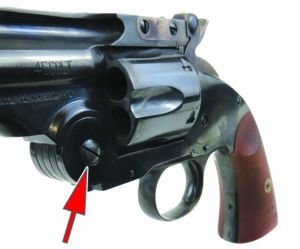
The top-break design’s advantage is speed to reload. A trained cavalryman could reload the Schofield revolver is less than 30 seconds. The Colt SAA takes almost 60 seconds. To load the cylinder, cock back the hammer to the first click. This does two things: First, it activates the modern hammer-block safety that engages a steel insert between the hammer and the frame. Second, it allows the stub latch to be pulled back so the barrel and cylinder can be pivoted away from the frame. You need to pivot the barrel/cylinder assembly as far as it will go so that the ejector snaps back into place, then you can load the chambers. We found we could unload the Schofield one handed by pulling back the latch and pivoting the barrel against our leg to eject the cases.
The fixed rear sight is built into the stub latch and offers the user a deep V-shaped groove. The front sight blade is half-moon style and finished a shiny gray so it sparkled in the sun’s glare, making it harder to shoot surgically.
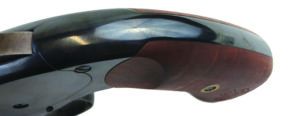
The balance point in the Schofield is forward of the trigger, making it front heavy. We also found our trigger finger rested high on the trigger and rubbed up against the bottom edge of the frame when we aimed. That bottom edge of the frame is beveled so shooting is comfortable. The trigger is wider than the Colt and Taylor’s and nearly was wide as the trigger guard. It was also heavy at 4.7 pounds. The weight — 53.2 ounces — helped manage recoil, especially in the speed-shooting segment.
In overall accuracy, the Schofield came in third with an aggregate average group of 2.19 inches. We were pleasantly surprised to find our best group measured 1.22 inches with the Hornady Cowboy 255-grain RNFP ammo because all the other revolvers averaged much larger groups with that load. The least accurate load with the Sellier & Bellot was a best group that measured 2.88 inches and an average that measured 3.24 inches. The Schofield did like the modern SIG load, giving us a best group of 1.57 inches and an average of 1.78 inches. Ironically, it did not care for the 45 Schofield ammo, shooting a best of 2.75 inches and an average of 2.77 inches.
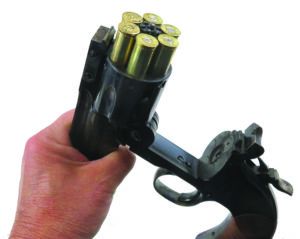
Going for speed, we found shooting with one hand was slow, as it was with all the revolvers, but cocking the hammer with the support hand increased speed. The curved shape of the back strap causes the gun to curl in your grip when shooting one-handed. With the balance point in front of the trigger, we noticed more muzzle flip with the Schofield. This gives you faster access to the hammer, and we found we were re-gripping the revolver after each shot. Shooting two handed changes the game because we could keep a tight grip with our shooting hand and let our support manipulate the hammer, which took about 4 pounds of effort. The high hammer spur is wide and checkered, making cocking the revolver a breeze. It took about 4.7 pounds of press to fire the pistol.
Our Team Said: The Uberti Schofield replica is another fine example of blending old aesthetics with modern technology. This is a fun revolver to shoot. The weight absorbs some of the recoil, and it is fast to reload.
45 Colt Range Data
To collect accuracy data, we fired five-shot groups from a bench using a rest. Distance: 15 yards with open sights. We recorded velocities using a ProChrono DLX digital chronograph set 10 feet from the muzzle.| SIG V-Crown 230-grain JHP | Colt Single Action Army | Taylor’s & Co. Drifter | Uberti 1873 Top Break | Uberti Outlaw |
| Average Velocity | 912 fps | 784 fps | 846 fps | 750 fps |
| Muzzle Energy | 425 ft.-lbs. | 314 ft.-lbs. | 366 ft.-lbs. | 287 ft.-lbs. |
| Smallest Group | 1.70 in. | 2.41 in. | 2.13 in. | 1.57 in. |
| Average Group | 2.15 in. | 2.70 in. | 2.23 in. | 1.78 in. |
| Hornady Cowboy 255-grain RNFP | Colt Single Action Army | Taylor’s & Co. Drifter | Uberti 1873 Top Break | Uberti Outlaw |
| Average Velocity | 782 fps | 679 fps | 738 fps | 648 fps |
| Muzzle Energy | 346 ft.-lbs. | 261 ft.-lbs. | 308 ft.-lbs. | 238 ft.-lbs. |
| Smallest Group | 3.22 in. | 1.55 in. | 2.10 in. | 1.22 in. |
| Average Group | 3.29 in. | 1.91 in. | 2.36 in. | 1.26 in. |
| Sellier & Bellot 250-grain RNFP | Colt Single Action Army | Taylor’s & Co. Drifter | Uberti 1873 Top Break | Uberti Outlaw |
| Average Velocity | 890 fps | 843 fps | 809 fps | 808 fps |
| Muzzle Energy | 440 ft.-lbs. | 395 ft.-lbs. | 363 ft.-lbs. | 362 ft.-lbs. |
| Smallest Group | 0.95 in. | 2.53 in. | 1.82 in. | 2.88 in. |
| Average Group | 1.31 in. | 2.68 in. | 2.03 in. | 3.24 in. |
| Choice Ammunition 250-grain RNFP | Colt Single Action Army | Taylor’s & Co. Drifter | Uberti 1873 Top Break | Uberti Outlaw |
| Average Velocity | 888 fps | 823 fps | 846 fps | 788 fps |
| Muzzle Energy | 438 ft.-lbs. | 376 ft.-lbs. | 397 ft.-lbs. | 345 ft.-lbs. |
| Smallest Group | 1.71 in. | 2.02 in. | 1.10 in. | 1.87 in. |
| Average Group | 1.92 in. | 2.17 in. | 1.32 in. | 1.92 in. |
45 Schofield Range Data
To collect accuracy data, we fired five-shot groups from a bench using a rest. Distance: 15 yards with open sights. We recorded velocities using a ProChrono DLX digital chronograph set 10 feet from the muzzle.| Choice Ammunition 200-grain RNFP | Colt Single Action Army | Taylor’s & Co. Drifter | Uberti 1873 Top Break | Uberti Outlaw |
|---|---|---|---|---|
| Average Velocity | 883 fps | 839 fps | 839 fps | 822 fps |
| Muzzle Energy | 346 ft.-lbs. | 313 ft.-lbs. | 313 ft.-lbs. | 300 ft.-lbs. |
| Smallest Group | 1.60 in. | 1.64 in. | 1.80 in. | 2.75 in. |
| Average Group | 1.76 in. | 1.77 in. | 1.82 in. | 2.77 in. |


























